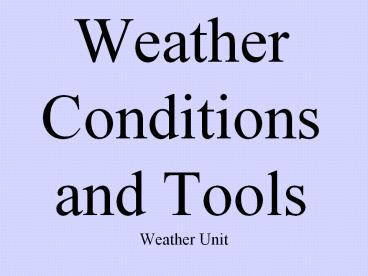Weather Conditions and Tools - PowerPoint PPT Presentation
1 / 30
Title:
Weather Conditions and Tools
Description:
Weather Conditions and Tools Weather Unit Weather changes occur day to day and from season to season. In order to understand daily weather conditions, weather data ... – PowerPoint PPT presentation
Number of Views:706
Avg rating:3.0/5.0
Title: Weather Conditions and Tools
1
Weather Conditions and Tools
- Weather Unit
2
Weather changes occur day to day and from season
to season.
3
In order to understand daily weather conditions,
weather data must be collected accurately using
weather instruments.
4
Wind Speed
The condition of how fast the air is moving
5
Wind Speed
Measured with an anemometer as the wind causes
the cups to spin
6
Anemometer
Wind speed is measured with an anemometer as the
wind causes cups to spin
7
Anemometer
How does it work? As the cups spin, the
anemometer counts how many times they spin in a
given period of time. The more turns, the
faster the wind speed
8
Wind Direction
The condition determined by where the wind/moving
air is coming from
9
Wind vane
Wind direction is determined with a wind vane
(weather vane). Wind direction is described by
the direction from which the wind is blowing.
10
Wind vane
How does it work?
11
Describing Wind Direction
12
Precipitation
The condition of the type of water falling to
Earth from the clouds
13
Rain gauge
Amount of precipitation is measured in a rain
gauge. Markings on the side show how much rain
has fallen.
14
Rain gauge
How does it work? Rain falls and collects in the
rain gauge. Markings on the side show the amount
of rain that has fallen. Measures rainfall in
inches.
15
Temperature
The condition of how warm or cold the air is at a
given time
16
Thermometer
Air temperature is read using a thermometer. The
scale may be read in degrees Fahrenheit or
Celsius. Air temperature should be measured out
of direct sunlight.
17
Thermometer
How does it work?
18
Seasons of the year change!
19
As the seasons of the year change, temperature
changes may cause precipitation changes.
20
Northerly winds may bring colder air than
southerly or westerly winds.What does that
mean?Winds blowing from the north may be colder
than winds blowing from the south or west.
21
Weather Conditions
- fair weather
- showers or light rain
- clear skies with cold temperatures
- days of clouds
- days of precipitation
- windy fair days
- windy stormy weather
22
Weather patterns involve weather conditions that
are repeated due to the season of the
year.Example Summer temperatures are
generally warmer than winter temperatures.
23
Weather Signs
- looking at clouds
- noticing changes in wind speed and noticing
changes in wind directions These can indicate
storms or temperature changes.
24
Weather Predictions
Based on qualitative and quantitative data-- NOT
JUST GUESSES! The predictions are based upon a
combination of types of data.
25
Meteorologists
Meteorologists interpret information from a
variety of sources and use those sources to make
predictions.
http//www.wistv.com/
26
Meteorologists
The information they use is shown on a weather
map.
27
Weather Maps
May show large masses of warm or cold air
movingLines between the air masses are called
fronts.
28
Weather Maps
May show large masses of warm or cold air
movingLines between the air masses are called
fronts.
Warm fronts When a warm front passes over an
area, the air temperature increases.
Cold fronts When a cold front passes over an
area, the air temperature decreases.
29
Data related to temperature and precipitation can
also be found on a weather map.
30
Weather Conditions and Tools
- Weather Unit































